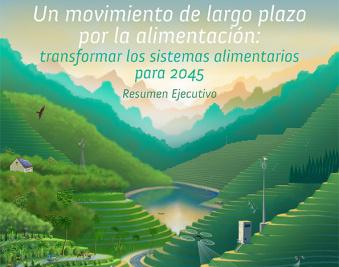A Long Food Movement: Transforming Food Systems by 2045
We consider what food systems could look like by 2045 if (agri)business-as-usual is allowed to run its course. We also imagine what could happen if, instead, the initiative is reclaimed by civil society and social movements.
- Análisis

In 2021, those working to build food systems that are just, equitable, and operate within planetary boundaries have our work cut out for us. Climate change, biodiversity loss, and rapidly declining soil fertility are critically damaging the health of people and the planet, dislocating societies, and threatening food systems around the world. Five years into a global commitment to eliminate hunger by 2030, we have lost significant ground. In 2019, an estimated 690 million people were hungry and upwards of 2 billion lacked regular access to safe, nutritious, and sufficient food. This was before COVID-19 added approximately 130 million people to the world’s hungry, pushed uncounted millions more to the brink of hunger, and put one third of food and farming livelihoods at risk.
At the same time, the locus of power in food systems and the broader global economy is shifting at dizzying speed. In 2008, the world’s most powerful corporations drilled oil wells and traded stocks. Twelve years later, the world’s five corporate titans all deal in intangible data and have a market valuation that exceeds the GDP of entire continents. The new biodigital giants are now primed for the next step: unleashing big data and digital DNA into the world's pharmacies, food markets, and financial systems. ‘Multi-stakeholderism’ is everywhere as corporations – sensing the social and environmental tipping points ahead – seek to draw governments, scientists and a handful of civil society organizations into an artificial new multilateralism.
Against this backdrop, we consider what food systems could look like by 2045 if (agri)business-as-usual is allowed to run its course. We also imagine what could happen if, instead, the initiative is reclaimed by civil society and social movements – from grassroots organizations to international NGOs, from farmers’ and fishers’ groups, to cooperatives and unions. We consider what this ‘Long Food Movement’ could achieve if it succeeds in thinking decades ahead, collaborating across sectors, scales, and strategic differences, working with governments and pressuring them to act, and transforming financial flows, governance structures, and food systems from the ground up.
Source:
https://www.etcgroup.org/sites/www.etcgroup.org/files/files/lfmexecsummaryen.pdf
Del mismo autor
- Vigilancia en los territorios: ¿qué es la agricultura 4.0? 30/11/2021
- A Long Food Movement: Transforming Food Systems by 2045 01/04/2021
- Países altamente emisores, productores de petróleo, siguen bloqueando la gobernanza de la geoingeniería en la ONU 15/03/2019
- Doce maneras de comenzar a entender el 2019 y más allá 05/02/2019
- Forcing the farm 22/10/2018
- Blocking the chain 19/10/2018
- Between BlackRock and a Hard Place: Is the Industrial Food Chain Unraveling ... or Rewinding? 17/10/2018
- Preocupación porque el IPCC incluye la geoingeniería en su nuevo reporte global 26/09/2013
- Quién controlará la economía verde? 19/12/2011
- El IPCC avanza con cautela 22/06/2011
Soberanía Alimentaria
- Gerson Castellano, Pedro Carrano 30/03/2022
- Silvia Ribeiro 29/03/2022
- Germán Gorraiz López 28/03/2022
- Silvia Ribeiro 16/02/2022
- Clara Sánchez Guevara 15/02/2022
